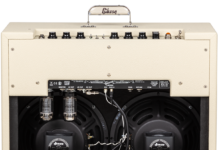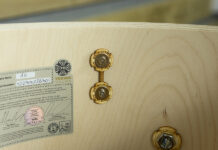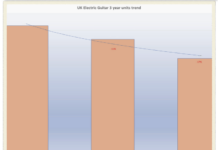
Master Sweeping by Learning the Rest Stroke
One thing I notice when working with students who want to improve their sweep picking is that, very often, they’re playing separate pick strokes instead of letting the pick brush through each string with no pause in the pick’s progress.
One thing I notice when working with students who want to improve their sweep picking is that, very often, they’re playing separate pick strokes instead of letting the pick brush through each string with no pause in the pick’s progress.
This is most noticeable when trying to play or practice a sweep arpeggio at a slow tempo. Even guitarists who are able to get the sweeping motion happening just fine at quicker tempos often revert to picking each string individually as soon as they slow it down to try and synchronize the hands.
This is because the natural momentum of pushing or pulling the pick through the string is easier to feel when done at a medium or quick tempo. However, trying to do this in a slow and controlled manner can be a challenge, which leads us to the point of this lesson: the rest stroke.
In classical guitar, a rest stroke is where the finger plucks a string (say the D string) and comes to rest on the adjacent string (in this case, the A string). Obviously this term applies to fingerstyle upstrokes, but if we steal it and apply this to our use of a guitar pick, a down stroke on the A string would see your pick coming to a halt against the side of the D string. An upstroke is the reverse.
Simple, yes? Try it now. Pick any note on any string, and try pushing your pick through and letting it come to a stop against the neighboring string. You’ll see that if you wanted to go ahead and play the next string, all you have to do is allow the pick to push through the string it’s resting against. Now try linking together two pick strokes. Start by picking through the A string, letting the pick come to rest against the D string and then pushing the pick through the D string and letting it come to rest against the G string. You’ve now just played two rest strokes in a row, which is starting to look like a sweep.
Now fret any chord and try to play it s-l-o-w-l-y, using only rest strokes. Don’t allow your pick to come away from the strings at all. If you managed that, you’ve just successfully performed sweep picking.
Hang on a minute! Isn’t this essentially the same as strumming a chord but a lot slower and more controlled? Yes, if you apply rest strokes over several strings, it’s exactly like that. However, when we start looking at more complex techniques, we often forget the “easy” fundamental movements that we use elsewhere in guitar playing—so we don’t think to apply them.
Now, armed with the rest stroke, you can work slowly on those arpeggio shapes and build up hand synchronization in a way that allows you to maintain the same sweeping motion you’d use if you were doing it at a faster tempo. Enjoy!
Ben Higgins started playing guitar at age 10. He’s released five solo albums and continues to teach guitarists from around the world. In 2012, he released the YouTube video “30 Shredders in One Solo,” in which he emulated the style of 30 of the world’s greatest guitarists. He followed it up with “30 Misplaced Shredders” and “Another 30 Shredders.” In 2016, Ben developed his “Badass…” online courses, which are aimed at improving people’s technique in picking, sweeping and hand synchronization. To find out more about Ben and his courses, visit benhigginsofficial.com.
Source: www.guitarworld.com












